Learning from NIST at the Time and Frequency Seminar
As we continue our development of the Broadcast Positioning System (BPS) I have become more immersed in the timing and frequency community. And this past week I had the great opportunity to attend the NIST Time and Frequency Seminar in Boulder, Colo. This was a tremendous gathering of subject matter experts, and I consider it a “mini master’s degree” in the basics of time delivery and synchronization techniques.

NIST scientist earned an Emmy for Closed Captions, work that grew out of a television time transfer project.
Even before the first session began, one of the first things I learned upon entering the building is NIST has a long history with timing and television. I was surprised and delighted to see an Emmy Award on display in the lobby. NIST scientists earned their Emmy Award in 1980 for developing the closed captioning system and improving television for the hearing impaired. That work started in 1968 with encoding time into television signals and then developing a transfer standard to keep remote clocks synchronized. So, while BPS is a new and innovative way of leveraging digital ATSC 3.0 signals to complement GPS, it builds on a long and analog history of terrestrial time transfer.

Two Way Satellite Time and Frequency Transfer (TWSTFT) dishes on the roof at NIST.
Over the next two and half days I learned about a wide range of topics, including:
- Atomic fountains
- Atomic clock ensembles
- Hydrogen masers
- Optical clocks
- Frequency offsets, frequency drift, phase noise
- Global Navigation Satellite Systems (GNSS), of which there are four:
- GPS – United States (Professor Axelrad from Colorado University gave an excellent presentation)
- Galileo – European Union
- Glonass – Russia
- BeiDou – China
- Regional augmentations by India, Japan and other nations
- Two Way Satellite Time and Frequency Transfer
- Common view
- Allan Deviation (ADEV) and Time Deviation (TDEV)
- Chip scale atomic sensors
- And so much more…

Jeff Sherman gives an overview of one of the atomic clock ensembles he manages.
One of the more interesting things to me is that the very definition of a second has evolved over time, and scientist are hoping to redefine it yet again. It would be reasonable to think there are simply 86,400 seconds in a day, meaning a second is defined as a unit of the calendar year. While that was once true, since 1967 the second has been defined by the properties of oscillation of a Cesium 133 atom under microwave frequencies. And one day (perhaps within the next six years) the second will be defined by the even more precise oscillation at optical frequencies. Each new definition offers greater precision.

Jeff Sherman explains atomic fountains to Harvey and Amir.
This seminar was a wonderful reminder of my mom’s wisdom, when she said, “The more you learn the more you realize you don’t know.” While I earned 30 credit hours and a course certificate, I came away with a firm knowledge that there is so much more I need to know.
Kudos to Liz Donley, Dave Howe, Jeff Sherman and the rest of NIST’s Time and Frequency team for putting on such an exceptionally educational event. Thanks as well to Duke Buckner, Greg Wolff and the team at Microchip for hosting the reception and sharing their expertise.

BPS receivers are just some of the equipment in NIST’s time transfer lab.
I look forward to continued collaboration as we work to add BPS as a vital terrestrial component to a resilient position, navigation and timing system.

